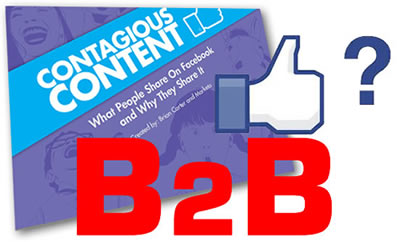Most people using Facebook for B2B don’t realise that 80% or more of their fans never see their posts. This shocking statistic has been around for just over a year now but when we read the new Facebook research produced by Marketo, published this month, "Contagious Content for Facebook: What people share on facebook and why they share it" we decided the time was ripe to do an article on how to beat it.
In Part 2 of this blog series. we share the key findings from that research and our top tips for how to incorporate this into your strategy for using Facebook for B2B marketing.
What’s The Problem?
Only about 1% of fans ever return to your Facebook fan page after they’ve liked it. Most people spend most of their Facebook time in their newsfeed (the posts they see on their homepage). No one sees every post from every friend or page they’ve liked. Facebook tries to show each person the things they’d be most interested in based on past posts you’ve clicked on, commented on, liked and shared.
Only a small percentage of your fans interact with your posts when they show up in their newsfeed. The fans who don’t click on your posts stop seeing you there. That means your Facebook Page isn’t going to be seen by all your fans.
In fact, Facebook said in February of 2012 that the average page was reaching just 12% of its fans. In 2007, a Facebook engineer said in an interview that only about 0.2% of eligible stories make it into a user's newsfeed. That means that your status update is competing with 499 other stories for a single slot in a user's newsfeed.
If you want your fans to see your posts, you need to get them to click on something in each post. This means creating posts that people either click, like, share or comment upon; we’re going to look at some key stats and share best practices on how to get this to happen when using Facebook for B2B.
The Purpose of The Post: Like vs. Share vs. Comment
The following statistics illustrate the benchmark averages researched by Marketo for different post interactions:
- 0.4% of fans commented on the average post
- 3.4% of fans liked the average post
- 0.4% of fans shared the average post
In addition to these findings, there wasn’t anything as simple as popular vs. unpopular posts; some encouraged lots of likes, some lots of shares and some lots of comments but posts that achieved all 3 in equal proportion were few and far between.
So why do people "like" more than they comment or share?
The logical conclusion cited by marketers using Facebook for B2B is that a “like” is less of a commitment than a share or a comment. Comments require the user to have an opinion and expose them to others and sharing implies a degree of approval and a desire for association with the content far greater than simply liking it. There is no passion in “liking”, so even though it is easier to achieve it is less desirable as likes are given less weight in the EdgeRank algorithm used by Facebook to prioritise posts. Smart marketers use a mixture of posts, designed to elicit all three types of response.
Ok, so why do people share?
Here are some statistics to consider taken from a recent New York Times study on social sharing.
- 75% say sharing helps them better understand and “process” news they’re interested in
- 85% say the responses they get from posting and sharing on a social media site provide more thought
- 94% consider how helpful a link would be to another user before posting it
- 68% share as an advertisement for themselves, to give others a better sense of who they are
- 73% say it helps them find people with common interests.
So there you have it; B2B marketers need to stay focused on creating content that encourages interaction on Facebook in order to make the most of their fan base.
Check out Part 2 in this blog series: Facebook for B2B: What You Need To Do To Create Highly Shareable Posts.

